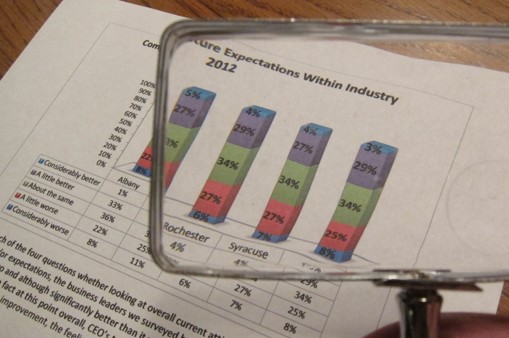First Annual Survey of Southwestern New England Business Leaders
2/14/12
Summary of Findings
Summary
The First Annual First Niagara Survey of Southwestern New England Business Leaders conducted by the Siena College Research Institute (SRI) shows that CEO confidence is at a point where optimism among business leaders exceeds pessimism. Today, more business leaders are positive about their current economic picture and far more are optimistic towards the future than are those that continue to express negativity and pessimism. A majority of the most confident (nearly 40%) predict an uptick this year in profits and nearly half of the most confident expect an increase in hiring. Most see a challenging rather than threatening year for area businesses. Southwestern New England is back to work. Expect these CEO’s to focus on growing their businesses by focusing on serving their clients, realizing in many cases markedly increased revenues and for some, greater profits. They will move to invest in their businesses and over a quarter will enlarge their workforce. 2012 should be a year of cautious growth in which most Southwestern New England businesses prosper or at least hold their own while they continue to be concerned with potentially adverse economic conditions, and state and federal governments that they don’t believe are doing enough to promote business.
Business Leader Confidence
The overall Index of Southwestern New England Business Leaders is 107.3 over 9 points above the index for Upstate New York but over 4 points under this year’s Pennsylvania score. The Index is well above the 100 mark at which equal percentages of CEO’s are both optimistic and pessimistic about economic conditions in their industry and across their state. The current index component that assesses business conditions today as compared to six months earlier is 99.7 right at the breakeven point and again greater than Upstate New York but trailing Pennsylvania. The future component that measures expectations for the coming year is 114.8 above Upstate New York’s 103.0 but below Pennsylvania’s 119.5. Forty-one percent of CEO’s of private, for-profit companies with sales between $5 million and $150 million in the Connecticut counties of Fairfield, Hartford, Middlesex, New Haven, Tolland and Windham and the Massachusetts counties of Hampden and Worcester now expect better economic conditions in their area next year. Only 24 percent expect worsening conditions.
This survey reports data from 324 corporate leaders drawn from Service (32%), Manufacturing (22%), Retail (14%), Engineering/Construction (12%), Financial (10%), Wholesale/Distribution (8%), and Food/Beverage (2%). If equal numbers of CEO’s had positive and negative perceptions of and expectations for the general economy as well as for the condition of and future for their industry, the overall index would be 100. Of those industries with substantial representation in the survey, Retail (105.6), Service (102.6) and Manufacturing (96.2) have the highest overall index readings. Of three Southwestern New England areas, the index is greatest in Fairfield (117.6 overall, 109.4 current, 125.8 future) followed by the two Massachusetts counties (112.4, 105.1, 119.7), and the five counties of Central Connecticut (100.3, 92.7, 108.0).
Twenty-nine percent of CEO’s say that business conditions have worsened in Southwestern New England over the last half of 2011 while 32 percent feel as though the economy has improved recently. CEO’s in Fairfield and Massachusetts are experiencing a recovery at a greater rate than those from Central Connecticut.
Based upon CEO’s responses to the four key index questions, the study identifies three distinct groups of business leaders today in Southwestern New England. Thirty-nine percent of CEO’s report being able to currently thrive and are strongly optimistic about the future. Forty percent of CEO’s acknowledge being seriously impacted by recent economic conditions, but they tend to feel as though things have stabilized or are just beginning to turn around. The remaining 21 percent have been very seriously affected by the economy and believe that economic conditions may continue to worsen in both Southwestern New England and their industry before getting better.
Revenues, Profits and Labor Force
Impressive percentages of CEO’s have robust expectations for revenues and profits through 2012. Additionally, a majority of CEO’s plan to acquire new fixed assets this year and three times as many business leaders plan to enlarge their workforce this year as compared with those that are contemplating lessening their workforce.
Nearly one half of CEO’s (49%) anticipate increasing revenues during 2012 as compared to only 15 percent that expect less revenue this year. Thirty-nine percent anticipate increasing profitability this year (NY 30%, PA 36%) while only 24 percent continue to expect declines.
While nearly half of CEO’s see increasing profits and almost 40 percent plan to turn those revenues into higher profits, the 53 percent planning fixed asset acquisition are somewhat surprisingly intent on using internally generated cash rather than leverage at a 3 to 1 ratio. Despite positive growth signs, even those planning on reinvesting in their businesses remain cautious.
Twenty-eight percent of business leaders expect to at least moderately increase their workforce in 2012. While 63 percent intend to have their workforce remain the same, 9 percent plan on decreasing their labor force. Although hiring plans dwarf layoffs, business leaders continue to grow only when necessary and while this prudent approach may assist profitability it will not as yet do more than chip away at current unemployment figures.
Concentrations, Challenges and Attitudes towards Government
As Southwestern New England CEO’s work to succeed in an economy that appears to be slowly recovering, they are split between those that focus on market and demand growth (41%) and those that focus on cost reduction as a strategy (31%). Optimistic companies tend to target growing sales while the more pessimistic companies still primarily look to cost cuts as a business strategy.
Nearly three-quarters of CEO’s cite health care costs as a challenging concern while 72 percent continue to worry about adverse economic conditions and nearly two-thirds are concerned with governmental regulation while over half cite taxation, energy and supplier costs as challenges.
Thirty-five percent of CEO’s call on their Governor and Legislature to cut spending as their top focus. While CEO’s continue to lack confidence in the ability of their state government to improve business conditions, their faith in state government is stronger than their faith in the federal government. CEO’s strongly support domestic energy development, a balanced budget amendment, reducing corporate income tax rates, capping annual increases in federal regulatory spending at $0, and repealing the recent health care legislation.




